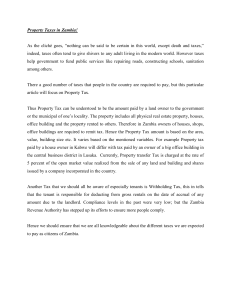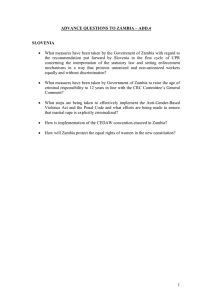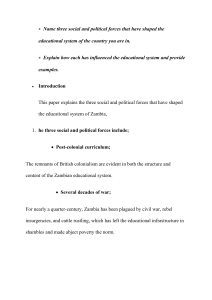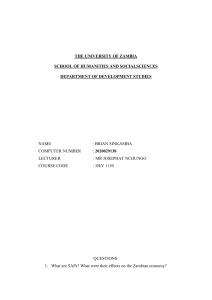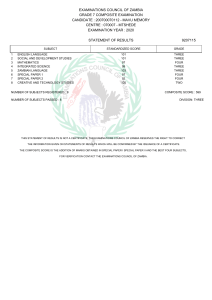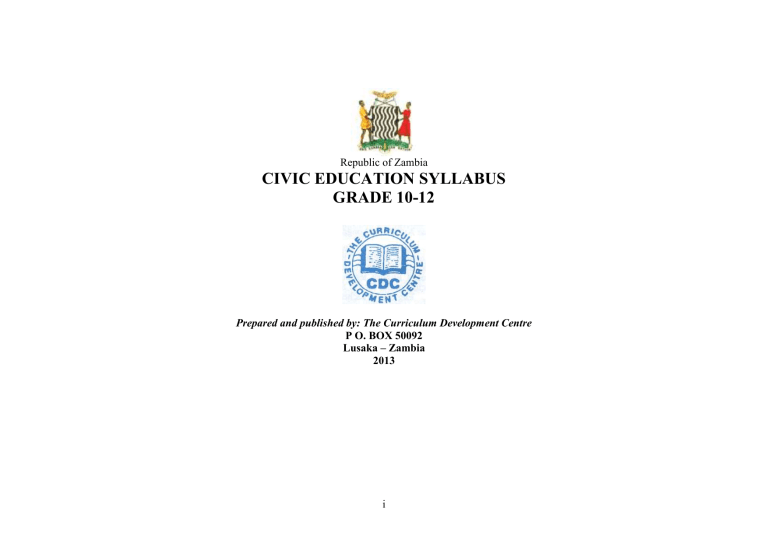
Republic of Zambia CIVIC EDUCATION SYLLABUS GRADE 10-12 Prepared and published by: The Curriculum Development Centre P O. BOX 50092 Lusaka – Zambia 2013 i Copyright © Curriculum Development Centre, 2013 All rights reserved. No part of this publication may be reproduced, stored in a retrieval system, or transmitted in any form or by any means, electronic, mechanical, photocopying, recording, or otherwise, without the prior written permission of the copyright owner. ii Vision Quality, lifelong education for all which accessible, inclusive and relevant to individual, national and global needs and value systems. iii PREFACE The syllabus was produced as a result of the Curriculum review process carried out by the Ministry of Education, Science, Vocational Training and Early Education under the auspices of the Curriculum Development Centre (CDC). The curriculum reform process started way back in 1999 when the Ministry of Education commissioned five (5) curriculum studies which were conducted by the University of Zambia. These studies were followed by a review of the lower and middle basic and primary teacher education curriculum. In 2005 the upper basic education National survey was conducted and information from learners parents, teachers, school managers, educational administrators, tertiary institutions traditional leaders civic leaders and various stakeholders in education was collected to help design a relevant curriculum ,. The recommendations provided by various stakeholders during the Upper Basic Education National survey of 2005 and National symposium on curriculum held in June 2009 guided the review process. The review was necessitated by the need to provide an education system that would not only incorporate latest social, economic, technological and political developments but also equip learners with vital knowledge, skills and values that are necessary to contribute to the attainment of Vision 2030. The syllabus has been reviewed in line with the Outcome Based Education principles which seek to link education to real life experiences that give learners skills to access, criticize analyze and practically apply knowledge that help them gain life skills. Its competences and general outcomes are the expected outcomes to be attained by the leaners through the acquisition of knowledge, skills, techniques and values which are very important for the total development of the individual and the nation as a whole. Effective implementation of Outcome Based Education requires that the following principles be observed: clarity of focus, Reflective designing, setting high expectations for all learners and appropriate opportunities. It is my sincere hope that this Outcome Based syllabus will greatly improve the quality of education provided at Junior Secondary School as defined and recommended in various policy documents including Educating Our Future`1996 and the `Zambia Education Curriculum Framework `2013. Chishimba Nkosha Permanent Secretary MINISTRY OF EDUCATION,SCIENCE, VOCATIONAL TRAINING AND EARLY EDUCATION. iv ACKNOWLEDGEMENTS The syllabus presented here is a result of broad-based consultation involving several stakeholders within and outside the education system. Many individuals, institutions and organizations were consulted to gather their views on the existing syllabus and to accord them an opportunity to make suggestions for the new syllabus. The Ministry of Education wishes to express heartfelt gratitude to all those who participated for their valuable contributions, which resulted in the development of this syllabus. The Curriculum Development Centre worked closely with other sister departments and institutions to create this document. We sincerely thank the Directorate of Teacher Education and Specialized Services, the Directorate of Planning and Information, the Directorate of Human Resource and Administration, the Directorate of Open and Distance Education ,the Examinations Council of Zambia, the University of Zambia, schools and other institutions too numerous to mention, for their steadfast support. We pay special tribute to co-operating partners especially JICA and UNICEF for rendering financial technical support in the production of the syllabus. C.N.M Sakala (Mrs) Director-Standard and Curriculum MINISTRY OF EDUCATION, SCIENCE,VOCATIONAL TRAINING AND EARLY EDUCATION v TABLE OF CONTENT PAGE COPYRIGHT ……………………………………………………………………………………………………………………………………………………… II PREFACE…………………………………………………………………………………………………………………………….……………………………… III ACKNOWLEDGEMENTS ……………………………………………………………………………………………………………………………………. INTRODUCTION …………………………………………………………………………………………………………… …………………………………. RATIONALE………………………………………………………………………………………………………………….. ………………………………….. GENERAL OUTCOMESS…………………………………………………………………………………………………..…………………………………. GRADE 10 . TOPIC 10.1 CONSTITUTION……………………………………………………………………………………………………. ………………………………….. IV V VII IX 10.2 GOVERNANCE…………………………………………………………………………………………………….. ………………………………….. 10.3 CITIZENSHIP……………………………………………………………………………………………………….. ………………………………….. 10.4 INTRODUCTION TO HUMAN RIGHTS……………………………………………………………………. ………………………………….. 10.5 CORRUPTION…………………………………………………………………………………………………….. ………………………………….. 10.6 CULTURAL STUDIES……………………………………………………………………………………………. ………………………………….. 10.7 SUBSTANCE ABUSE………………………………………………………………………………………………. ………………………………….. 3 5 6 7 9 11 GRADE 11 TOPIC 11.1 THE ZAMBIAN BILL OF RIGHTS……………………………………………………………………………… ………………………………….. 11.2 CIVIL SOCIETY AND MEDIA IN GOVERNANCE………………………………………………………… ………………………………….. 11.3 ECONOMIC AND SOCIAL DEVELOPMENT………………………………………………………………..…………………………………. 11.4 ZAMBIA’S LEGAL SYSTEM ……………………………………………………………………………………. ………………………………….. 11.5 GENDER EQUITY AND EQUALITY………………………………………………………………………….. ………………………………….. 11.6 CULTURE OF PEACE …………………………………………………………………………………………… ………………………………….. 13 14 16 17 19 21 vi 1 11.7 CHILD ABUSE………………………………………………………………………………………………………. 23 GRADE 12 TOPIC 12.1 INTERNATIONAL HUMAN RIGHTS INSTRUMENTS ………………………………………………………………………. 12.2 RIGHTS OF A CHILD……………………………………………………………………………………………………………………… 12.3 FAMILY LAW………………………………………………………………………………………………………………………………. 12.4 DEVELOPMENT PLANNING………………………………………………………………………………………………………….. 12.5 POVERTY REDUCTION IN ZAMBIA………………………………………………………………………………………………….. 12.6 GLOBAL ISSUES………………………………………………………………………………………………………………………….. APPENDIX ONE………………………………………………………………………………………………………………………………….. SCOPE AND SEQUENCE CHART GRADE 10 – 12………………………………………………………………………………………. 24 27 28 29 31 32 34 34 vii INTRODUCTION The Senior Secondary school civic Education curriculum addresses a cross – section of political, economic, social and cultural issues that are key to Zambia’s democratic system of governance. The topics include among others constitution, Governance, citizenship; Human rights, corruption Legal Education, Family law and Global issues. These topics are based on the set of the National Policy on Education “Educating Our Future (1996), Page 5 – 6. The ultimate aim of this syllabus is to enable school leavers gain civic knowledge and acquire stills that are necessary for them to understand and practice their Civic rights and obligators with responsibility within and outside Zambia. METHODOLOGY A variety of learner-centered methodologies are covered in this syllabus. These are; Group discussions, note pray, debate, case studies, circle time and development campus rose. In addition, national project a field work component is included to provide learners with an opportunity to acquire research, analysis evaluation and report skills. TIME ALLOCATION. Learners shall have five (05) periods of forty (40) minutes duration each per week. ASSESSMENT It is expected that learners will be assessed periodically to determine whether the intended outcomes have been internalised and competences mastered. For the sake of this, teachers are advised to conduct Continuous Assessments, whether weekly or fortnightly or monthly. A mid-term assessment would also be ideal so that where deficiencies are observed some remedial measures are put in place. However, it is strongly recommended that an end-of-term assessment be conducted at each grade level. 1 RATIONALE The Civic Education Component is currently integrated in the Social and Development Curriculum covered at Grades 1-7and the Junior – Secondary School Social Studies syllabus (Grade 8-9). The introduction of Civic Education at High School level was to fill the gap that existed between Junior Secondary School and College or University level of education. This gap has had an impact on Senior Secondary school leavers who in most cases graduated with little or no experience of Civic Education with regards to their roles, rights and obligation. Hence, this major development in the curriculum was identified as an important contribution to Zambia’s education system that is based on democratic principles and values. The Senior Secondary School covers content on a cross section of political, economic, social and cultural things that are key to Zambia’s democratic system of Governance. Undoubtedly, the teaching and learning of Civic Education will help society recognize the role that this subject plays in our constantly changing world. The Ministry of Education, therefore, hopes that through civic education learners will be equipped with knowledge; skills and values to enable them practice their civic rights and perform duties as responsible Zambian citizens at local, national and international level.. 2 GENERAL OUTCOMESS 1. Creating an understanding of the political process and appreciation of good governance. 2. Promoting positive attitudes, responsibilities, duties, obligations, freedoms and rights of a citizen in the learner. 3. Creating awareness on the need for respect, promotion of democracy, human rights and freedoms. 4. Developing an understanding of global issues. 3 GRADE 10 GENRAL OUTCOMES: Creating an understanding of Zambia’s political process and appreciation of good governance. Develop an understanding of the duties, responsibilities, freedoms and rights of a citizen. Develop understanding, respect and promotion of Human Rights. KEY COMPETENCIES Demonstrate ability to participate in constitution making process and adoption Show ability to carry out Civic duties with responsibility Demonstrate ability to report corruption cases to relevant authorities. TOPIC 10.1 CONSTITUTION SUBTOPIC SPECIFIC OUTCOMES 10.1.1 Describe types of constitution 10.1.2 Explain the main parts of the Zambian constitution. Knowledge Types of constitutions:Written and Unwritten (Flexible and Rigid Constitutions) 10.1.3 Describe the process of constitution making and adoption. 10.1.4 Discuss the characteristics of a good constitution. 10.1.5 Explain the importance of a constitution to a nation. 4 Parts of the Zambian constitution: Citizenship, Executive, judicature, House of Chiefs etc Constitution making process and adoption: Review Commissions, National debate, Constituent Assembly, Parliament, Referendum, Constitutional Conference. Characteristics of a good constitution: Clear, Stand taste of time, protects rights of citizens etc. Importance of a CONTENT Skills Values Classification of different types of constitution Participation in constitution making process and adoption Analysis of a good constitution Appreciation of a good constitution constitution: Enhances democratic governance, promotes protection of rule of law e.t.c 5 TOPIC 10.2 GOVERNANCE SYSTEM IN ZAMBIA SUBTOPIC SPECIFIC OUTCOMES 10.2.1 Explain governance 10.2.2 Discuss the characteristics of good and bad governance. 10.2.3 Analyse different Electoral systems. 10.2.4 Explain Zambia’s Electoral system Knowledge Governance: Ruling with or without consent. Good governance: Respect for human rights, political tolerance, regular free and fair elections etc Bad governance: lack of separation of powers, violation of human rights, arbitrary arrests, corrupt leadership Electoral systems: Single Member Plurality System (SMPS) or First Past The Post (FPTP), Single Member Majoritarian System (SMMS) or Fifty plus One, Proportional Representation System (PRS), and Mixed Member Proportionality System (MMPS) Election characteristics in good governance: Periodic, competitive, inclusive and decisive Zambia’s Electoral System: Single Member Plurality System (1996 Constitution) Electoral process: Legislation, delimitation, registration of voters, verification of voters roll etc Electoral Code of Conduct(2006) Types of elections: - Primary, Tripartite (General) and Byelections. 6 CONTENT Skills Differentiation between good and bad governance Analysis of different types of lections Identification of Zambia’s electoral system. Values Local Governance before and after 1964 10.2.5 Describe the Local Government system in Zambia Decentralisation Acts of1980 and1991 Functions of Local Councils 10.2.6 Discuss the role of traditional leaders in governance The House of Chiefs Resolving civil disputes. Allocating plots under customary law. Participating in Development Projects in their area. 7 Participation in Electoral activities. TOPIC 10.3 CITIZENSHIP SUBTOPIC SPECIFIC OUTCOMES Knowledge Citizenship: A member of the community who enjoys all rights and privileges provided by a state. Legal and moral aspects of citizenship, natural and naturalised citizenship 10.3.1 Explain citizenship. 10.3.2 State qualifications of a Zambian citizen 10.3.3 Describe qualities of a good citizen. 10.3.4 Identify factors that hinder good citizenship 10.3.5 Explain the rights and freedoms of a citizen . 10.3.6 Explain duties and responsibilities of a citizen. 10.3.7 Identify groups of people and citizens with special needs 8 CONTENT Skills Identification of types of citizenship. Classification of rights and freedoms of a citizen. Qualifications: Part Two of the 1996 Amended Constitution, Articles 4, 5 and 6 Qualities: Patriotism, respect for law, selfcontrol, honest Obstacles to good citizenship: Poverty, corruption, theft, selfishness, etc Rights and freedoms of a citizen: Natural, moral and legal rights Personal: supporting ones family Civic: Paying taxes People with special needs: Refugees, aged, persons with disabilities, children and youth. Values Patriotism Responsibility Selflessness Empathy Appreciation Awareness Integrity Honesty TOPIC 10.4 INTRODUCTION TO HUMAN RIGHTS SUBTOPIC SPECIFIC OUTCOMES 10.4.1 Describe Human Rights. CONTENT Knowledge Skills Human rights: Claims and Classification of freedoms of every human human rights being. categories The Charter of Mande (1222) Universal Declaration of Human Rights (UDHR 1948) 10.4.2 Discuss Characteristics of Human Rights 10.4.3 Explain categories of Human Rights 10.4.4 Identify ways in which human rights are violated 10.4.5 Discuss the significance of human rights 9 Values Promotion of human rights Characteristics: Inherent, inalienable, universal, indivisible and interrelated Categories: Civil and political rights, e.g., right to life Economic, social and cultural rights, e.g., right to food Collective rights, e.g., right to self-determination Human rights violations: Child abuse, human trafficking, corruption, corporal punishment, gender based violence, forced marriages, arbitrary arrest Significance of human rights: Focus on human dignity, peace and freedom respect for everyone’s life and taking up one’s responsibility. Analysis of human rights violations Respect for human rights TOPIC 10.5 CORRUPTION SUBTOPIC SPECIFIC OUTCOMES Knowledge Corruption: Bribery and abuse of authority of office 10.5.1 Describe corruption. Types of corruption: Petty, grand and political (electoral) 10.5.2 Discuss types of corruption Causes of corruption: Social, e.g., personal greedy and dishonesty weak moral values, uninspiring leadership, lack of information Economic e.g., insufficient resources and services, poor economic policies Political, e.g., vote buying 10.5.3 Explain causes of corruption. 10.5.4 Explain effects of corruption. Effects of corruption: Widespread bitterness, increases crime, economic stagnation/distortion of standards, discourages investment, 10.5.5 State institutions that fight against corruption in Zambia . Anti-Corruption Commission (ACC), 10 CONTENT Skills Classification of different types of corruption. Classification of different types of corruption. Values Accountability of public resources Transparency of Services in public office Analysis of the causes and effects of corruption. Integrity in discharge of duties in public office Auditor-General’s office, Drug Enforcement Commission (money laundering unit), Zambia Police Service, media, Civil Society Organisations. 10.5.6 Identify the role of public officers, community and the youth in fighting corruption. 11 Public officers: adherence to set guidelines and regulations, reporting corruption, adherence to institutional and public service code of ethics, sensitisation. Community: reports suspected cases of corruption, sensitisation, advocacy for stronger laws. Youth: report cases, formation of Anticorruption clubs, sensitisation, adherence to the rule of law. Public interest disclosure (Whistle Blowers protection) Act No 4 of 2010 Identification of the role of citizens in fighting corruption. Institute blowing on corrupt activities TOPIC 10.6 CULTURAL STUDIES SUBTOPIC SPECIFIC OUTCOMES 10.6.1 Describe Culture 10.6.2 Outline components of culture. 10.6.3 Explain characteristics of culture. 10.6.4 Discuss the importance of culture. 10.6.4 Explain types of culture. 10.6.5 Identify Zambia’s societal core values. 10.6.6 Discuss Zambia’s cultural practices. 12 CONTENT Knowledge Skills Culture: People’s Identification complete way of of life such as values, components, beliefs and characteristic traditions. and types of culture. Components: language, religion, technology, material etc Characteristics: dynamic, learnt, shared , cumulative etc Importance of culture: Article 27 of UDHR, cultural heritage, identity, economic development, shaping behaviour. Types of culture: Folk, popular, ideal, real etc Societal core values: Respect for elders, cooperation, hard work and obedience to authority Cultural practices: Rights of passage, Values Appreciation of Zambia’s culture 10.6.7 Identify factors that affect the appreciation of cultural diversity in Zambia. 10.6.8 Describe global culture 10.6.9 Identify institutions that preserve cultural heritage in Zambia 13 traditional ceremonies, traditional attires etc Obstacles to cultural diversity: Stereotyping, prejudice, enthnocentricism, cultural relativism. Global culture: Sharing of cultures across countries. Agents of global culture (cultural imperialism): technology, mixing of cultures, tourism, trade. Institutions of cultural heritage: C. Museums (map of Zambia), National Heritage Conservation Commisison, National Arts Council, Ministry of Tourism and Art. TOPIC 10.7 SUBSTANCE ABUSE SUB-TOPIC SPECIFIC OUTCOMES 10.7.1 Describe types of substances often abused by people. Knowledge Taking something often the body does not need and for the wrong reasons. Over the counter substances, controlled substances. Depressants, Stimulants, Hallucinogens, Narcotics (opiates), inhalants. 10.7.2 Discuss substances and their effects. Effects of different substances such as: alcohol, tobacco, inhalants, cannabis,heroin and cocaine. 10.7.2 Explain reasons for substance abuse. Peer pressure, curiosity, stress, ignorance etc. Signs and symptoms of substance abuse How to avoid substance abuse 14 CONTENT Skills Values Classification Awareness of different of types of dangerous substances types of often abused substances by people promotion of integrity Dependence on substances. 10.7.3 Discuss effects of substance abuse on individuals, community, national and international levels. Diseases, crime, insanity, loss of productivity etc 10.7.4 Identify institutions involved in fighting substances abuse in Zambia. Drug Enforcement Commission, Police Service, Pharmaceutical Regulatory Authority, etc. 15 GRADE 11 GENERAL OUTCOMES Develop an understanding of Civil Society and Media participation in Governance System Develop an understanding and appreciation of Economic and Social Development in Zambia KEY COMPETENCIES Show ability to hobby and advocate for good governance Demonstrate ability to participate in public debates on topical issues Demonstrate ability to resolve conflicts Show ability to report cases of harassment to relevant authorities. TOPIC 11.1 THE ZAMBIAN BILL OF RIGHTS SUB-TOPIC The Zambian Bill of Rights SPECIFIC OUTCOMES 12.1.1 Describe the Bill of Rights. 12.1.2 Elements of the Bill of Rights in the Zambian Constitution. 12.1.3 Describe ways of enforcing the Zambian Bill of Rights. 11.2 Civil Society and Media in Governance Civil Society and governance CONTENT Knowledge Bill of Rights; Fundamental rights and freedoms covered in part III of the Zambian Constitution(1996) Articles 11-32 of the Zambian Constitution(1996) Enforcement: Courts, Judicial Review Commission, use of Human Rights Commission, Office of Investigator General. 12.1.4 Discuss the role of the Encourage, respect and Institutions that promotion of Human Rights promote Human Rights among other people. in Zambia. 11.1.1 Describe Civil Society Civil Society Organisations. Organisations: Nonmilitary and nongovernmental organisations that promote good governance. Classes of Civil Society: 11.1.2 Classify Civil Society Civic organisations, faith- 16 Skills Values Analysis of works of enforcing the birth of rights Classification of Civil society organisations Respect for human rights Promotion of accountability and transparency in governance structures. Organisations in Zambia Media and Governance based organisations, industrial labour organisations, professional associations 11.1.3 Analyse the roles of Civil Society in governance 11.1.4 Discuss forms of Citizen participation in governance 11.1.5 Identify different types of media. 11.1.6 Explain the role of the media in governance 11.1.7 Analyze factors that limit media coverage Roles of Civil Society: Defending ideals of democracy, influencing public opinion, promoting transparency and accountability, advocating for effective laws Citizen participation: Political, civil society and community activities (Factors that hinder women participation in governance such as male dominance, poverty, cultural issues.) Types of media: Print and electronic media (Private and public media) Media role: Informing and educating, acting as a watchdog, promoting public debate, promoting transparency and accountability (Conditions for the existence of an independent media.) Media coverage limitation: Accessibility, Language, cost of advertising, inadequate facilities for the physically challenged 17 Lobbying and advocating for good governance Classification of different types of media. Analysis of the role of the media in governance Respect for media freedom persons. 11.1.7 Identify factors that hinder the media from disseminating correct information Corruption, political pressure, intimidation, nonadherence to standards and ethics, censorhip. 18 TOPIC 11.3 Economic and Social Development SUB-TOPIC SPECIFIC OUTCOMES 11.2.1 Explain economic and social development 11.2.2. Discuss basic human needs 11.2.3 Describe factors that affect production CONTENT Knowledge Skills Economic and social development: Increase in productive capacity and improvement in standards of living Basic human needs: Food, shelter and clothes 11.2.4 Explain the importance of standards in economic and social development 11.2.5 Analyse the contributions of financial institutions to economic and social development. 11.2.6 State the role of the informal sector in national development 11.2.7 Explain the importance of positive work culture in economic and social development 11.2.8 Identify factors that hinder positive work culture 19 Factors:Land, labour and capital Role of trade unions. Enhanced trade leading to increased economic activities, incomes and high standard of living, enhanced public health and safety Lending, money transfer services, insurance Role of informal sector: Employment, production of goods and services Importance of positive work culture: High productivity of goods and services Obstacles to positive work culture: Corruption, poor conditions of service, poor leadership, Values Promoti on of hard work TOPIC 11.4 Zambia’s Legal system SUB-TOPIC SPECIFIC OUTCOMES 11.4.1 Describe Law 11.4.1 Explain Legal system 11.4.2 Discuss elements of a good legal system, Knowledge Law: Set of rules that regulate human behaviour in society. Legal system: A set standard which a society develops for itself to control the behaviours of its members towards one another. Elements of a good legal system: Simple, comprehensive, certain flexible, accessible etc. 11.4.3 Describe sources of Law in Zambia Sources of law: English or common Law, Legislation such as Constitution and statutory instruments, customary law, case law and international treaties. 11.4.3 Explain criminal and civil cases Criminal case: any wrongful act or omission that affects society as stipulated in the penal code. Elements of a crime and types of a crime. Civil case: any wrongful act that affects the individual or persons involved as stipulated in the customary laws. Trial stages:Pre-trial, trial and post-trial stages. 11.4.4 Describe the trial stages in the Zambian Legal System 20 CONTENT Skills Classification of Criminal and Civil cases Analysis of sources of Law. Identification of that stages. Values Respect for the Law 11.4.6 Discuss capital punishment Capital punishment: Death penalty Arguments for and against death penalty 11.4.7 Explain factors that hinder the administration of justice 11.4.5 Identify Legal institutions and organisations that promote justice Justice institutions: Ministry of Justice, Courts of Law, Legal Resource Foundation, Law Association of Zambia, Women in Law in Southern Africa, Police etc Obstacles to justice administration: Corruption, political influence, non adherence to ethics, incompetence, weak laws, lack of confidence in the judicial system, undue delays, 21 Analysis of the controversy of the death penalty TOPIC 11.5 Gender Equity and Equality SUBTOPIC SPECIFIC OUTCOMES 11.5.1 Explain gender equity and gender equality. 11.5.2 Outline the Historical background to gender equity and equality. 11.5.3 Distinguish gender roles from sex roles. 22 CONTENT Knowledge Skills Gender: state of being Conflict male or female. resolution in the family Equity: is the process of treating males fairly in order to achieve their equal status. Equality: refers to similar opportunities of development given to males and females without any set limitations. Historical background: United Nations Declaration on Elimination of all Forums of Discrimination against women (1967). Convention on Elimination of all Forms of Discrimination against Women (Cedaw). Beijing Conference on gender (1995). Gender in Development Division (1996). National Gender Policy (2000) etc. Ministry of Gender(2005) Gender roles: tasks and responsibilities which are differently assigned by society for males and females. Sex roles:tasks determined by biological differences between males and females. Values Awareness of general equity and equality in society. 11.5.4 Explain the social construction of gender. 11.5.5 Discuss Gender issues in traditional and modern society. 11.5.6 Describe Gender based violence 11.5.7 Analyse the Intestate Succession Act of 1989. 11.5.8 Describe Government Institutions and Civil Society Organisations that promote gender equity and equality. 23 Gender social construction: Socialisation process based on patriarchal beliefs. Agents of socialisation : family, school and church. Gender Issues:Land allocation , decision making, customary laws and statutory GBV: Violence (physical, Psychological and structural), Sexual harassment, Rape e.t.c. Intestate succession Act: Act of Parliament No. 14 of 1989. Terms guiding distribution of deceased person’s estates and personal chattels. Government institutions: Ministry of Gender, Courts, Zambia Police, Civil Society Organisations: Justice for Widows and Orphans Project (JWOP) Young Women Christian Association (YWCA) etc. TOPIC 11.6 Culture of Peace SUB-TOPIC SPECIFIC OUTCOMES 11.6.1 Explain culture of peace Knowledge Culture of peace: Absence of conflict and war 11.6.2 Describe methods of promoting peace Peace promotion: Intermarriages, tolerance, justice, forgiveness, respect etc. 11.6.3 Identify levels of conflict Conflict levels: Individual, community, national, international CONTENT Skills Mediation and negotiation between conflicting parties Values Promotion of tolerance and justice in society. 11.6.4 Analyse causes of conflict Causes of conflict: Religion, imbalance of natural resources, poverty, injustice, etc. 11.6.5 Discuss effects of conflict on society 11.6.6 Describe conflict resolution strategies 11.6.7 Discuss the role of United Nations in promoting peace. Effects of conflict: Death, migrations, destruction of infrastructure, etc. Conflict resolution strategies: Counselling, negotiation, mediation, arbitration, litigation Role of United Nations: Peacekeeping, conflict management and resolution. 24 Awareness of conflict management strategies in society. TOPIC SUB-TOPIC SPECIFIC OUTCOMES 11.7 Child Abuse 11.6.1 Describe child abuse Child abuse 11.6.2 Explain different forms of child abuse 11.6.3 Discuss ways of addressing child abuse Sexual harassment 11.6.4 Describe sexual harassment 11.6.5 Discuss ways of protection against sexual harassment and rape. Teenage pregnancies 11.6.6 Explain causes of teenage pregnancies 11.6.7 Explain the effects of teenage pregnancies. 11.6.8 Identify ways of preventing teenage pregnancies CONTENT Knowledge Skills Values Child A buse: Ill-treatment of a Classification Respect for child physically or mentally of different children’s’ types of child rights. Forms: Sexual abuse, sexual abuse. harassment, child defilement, child battering, child neglect, child trafficking, child prostitution and child labour Addressing child Abuse: Legislation, stiff punishment on offenders, community sensitisation, etc. Sexual harassment: touching or making sexual remarks against Analysis of someone’s wishes causes and Sexual harassment protection: effects of Making home secure, getting various types help from police, etc. of child abuse. Causes of teenage pregnancy: Peer pressure, economic and cultural issues, lack of sex education, etc. Effects of teenage pregnancy: Stigmatisation, child dumping, school dropping out, etc. Preventing teenage pregnancy: Reversing negative cultural practices, counselling, peer 25 11.6.9 Discuss institutions that address social challenges 26 education, Zambia police, Young Women Christian Association, judiciary (courts), etc. GRADE 12 GENERAL OUTCOMES: Develop respect and understanding of the Rights of the Child. Develop on understandings and appreciation of Development Planning. Develop an understanding of globalisation and global issues. KEY COMPETENCIES Demonstrate ability to resist human rights violations Show ability to adhere to fiscal discipline on Financial expenditure Demonstrate ability to work hard for poverty reduction TOPIC 12.1. International Human Rights Instruments SUB-TOPIC SPECIFIC OUTCOMES 11.3.1 Describe the International Bill of Rights(IBR) 11.3.2 Explain the Universal Declaration of Human Rights (UDHR) 27 Knowledge International Bill of Rights: Universal Declaration of Human rights (UDHR), International Covenant on Civil and Political Rights (ICCPR), International Covenant on Economic, Social and Cultural Rights (ICESCR), Specialised Instruments UDHR: Charter Based International Human Rights Instrument; contains 30 articles such as right to life. CONTENT Skills Classification of various human rights instruments Values Respect for human rights 11.3.3 Describe Treaty Based Human Rights Instruments Treaty Based Human Rights Instruments: International Covenant on Civil and Political Rights (ICCPR), with two optional protocols and International Covenant on Economic, Social and Cultural Rights (ICESCR) 11.3.4 Discuss the Specialised Human Rights Instruments 11.3.5 Explain provisions of the African Charter on Human and People’s Rights. Specialised Human Rights Instruments: United Nations Convention on the Rights of the Child (UNCRC), United Nations Convention Against Corruption (UNCAC), Convention on the Elimination of All Forms of Discrimination Against Women (CEDAW), etc. 28 Individual rights such as rights to equality and integrity of persons. Peoples rights such as right to self determination sovereignty over the environment and its resources. NEPAD, APRM 29 TOPIC 12.2 RIGHTS OF A CHILD SUB-TOPIC SPECIFIC OUTCOMES 12.2.1 Describe Children’s Rights. 12.2.2 Describe the four principles of the United Nations Convention on the Rights of the Child (UNCRC). Knowledge Children’s Rights: Rights enjoyed by persons below the age of 18. Principles: NonDiscrimination, the Best Interests of the Child, Survival and Development and Participation. 12.2.3 Discuss the provision of the UNCRC and the two optional protocols. 30 Provisions : Child Rights and Freedoms, Name and Nationality, preservation of identity freedom of thought, conscience and religion, Freedom of association etc. CONTENT Skills Analysis of children’s rights Values Respect for children’s rights TOPIC 12.3 FAMILY LAW SUBTOPIC SPECIFIC OUTCOMES 12.3.1 Describe family and marriage. Knowledge Family: Group of people related by blood or marriage. Marriage: Legal union of man and woman as husband and wife 12.3.2 Explain the elements of Family Law. 12.3.3 Describe types of marriages in Zambia. 12.3.4 Assess the effects of separation, divorce and death on the family. 31 Elements of family law: Marriage, divorce, death, property settlement, adoption of children succession etc. Types: Statutory and customary. Effects Separation divorce and death effects: Impact on spouse children and extended family CONTENT Skills Analysis of types of marriages Values Promotion of harmony in a family. Classification of various elements of family law Respect for human rights TOPIC 12.4 DEVELOPMENT PLANNING SUBTOPIC SPECIFIC OUTCOMES 12.4.1 Explain development planning. 12.4.2 Discuss types of development planning. Knowledge Development planning: Plan of set suggestions aimed at achieving set goals in future. Types: short term plan, medium term plan and long term plan. 12.4.3 Describe methods of planning. Methods of planning: Centralised planning and Decentralised planning. 12.4.4 Discuss the importance of budgeting and fiscal discipline in development planning. Budgeting and fiscal discipline: Ensures strict control of public resources and compliance in taxation and public expenditure Functions: Provision of loans, funding of large scale project infrastructures. 12.4.5 Explain the functions of micro and macro-economic financial institutions. 12.4.6 Examine indicators of development. 12.4.7 Outline Zambia’s National Development plans from Independence to present: 32 CONTENT Skills Prioritisation in development planning Indicators of development: Gross National Product, Gross Domestic Product. Human Development Index and Per Capita Income. Zambia’s Development plans: Emergence Development Plan (EDP), National Analysis of types of planning Values Knowledge of fiscal discipline in budgeting Transitional Development Plan (NTDP), First National Development Plan (FNDP), Second National Development Plan (SNDP)1972-1976, (TNDP) 1980-1983, Fourth National Third National Development Plan Development Plan (FNDP) 1983-1989, Transitional National Development Plan (TNDP) 2000, Vision 2030, Fifth National Development Plan (FNDP) and Sixth National Development Plan (SNDP) 33 TOPIC 12.5POVERTY REDUCTION IN ZAMBIA SUBTOPIC SPECIFIC OUTCOMES 12.5.1 Describe poverty. CONTENT Knowledge Poverty: Lack of basic needs. 12.5.2 Explain the causes of poverty. Causes of poverty: Debt burden, external dependence, climatic variations, conflict, poor work culture etc. 12.5.3 Assess the effects of poverty Effects of poverty: Hunger, food insecurity, high unemployment levels, increase in crime,conflicts,corruption 12.5.3 Discuss poverty alleviation strategies. Poverty alleviation strategies: Improving education and health services, increasing access to safe water and sanitation, promoting rural electrification etc. 12.5.4 Evaluate poverty alleviation strategies and their implementation in Zambia Poverty Reduction Strategy Paper(PRSP) with focus on microeconomics,Agriculture,Tourism,Mining,Health,Edu cation.e.tc 34 Skills Analysis causes and effects of poverty Values Promotion of discipline and hard work. TOPIC 12.6 GLOBAL ISSUES SUBTOPIC SPECIFIC OUTCOMES 12.7.1 Explain globalisation and global issues. 12.7.2 Discuss Bilateral and multilateral aid. 12.7.3 Discuss International trade. 12.7.4 State the role of the World Trade Organisation(WTO) 12.7.5 Explain debt crisis and debt relief. Knowledge Globalisation: Making wide extension or linkages to all parts of the world, Global issues: Global warming, corruption, war, terrorism etc Bilateral Aid: Assistance from one country to another Multilateral Aid: assistance from international agencies formed by several countries. Trade between different countries Reasons for international trade 12.7.6 Discuss the effects of debt crisis on 35 Role of WTO: Administering technical barriers to trade (TBT) and sanitary and phytosanitary (SPS) agreements.(Zambia member of WTO) Debt crisis: Borrowing beyond one’s capacity to pay back. Debt Relief; Ability to pay back debts Unfair international CONTENT Skills Analysis of causes and effects of debt Crisis Values Appreciation of coexistence Zambia. 12.7.7 Explain Millennium Development Goals (MDGs). 12.7.8 Analyse Zambia’s efforts towards the attainment of the Millennium Development Goals. 36 trade, debt servicing. Spending loans on consumption etc. Eight global development targets agreed by world leaders at UN millennium summit in 2000 to be achieved by 2015.E.g primary education for all, eradication of poverty e.tc. Introduction of Poverty Reduction Strategy paper, provision of subsidised fertilizer to subsistence farmers, introduction of free basic education from grade one to seven etc. APPENDIX 0NE: SCOPE AND SEQUENCE CHART – 10 TO 12. S/N 1. THEME GOVERNANCE GRADE 10 System of Governance in Zambia 2. CONSTITUTION The Zambian Constitution 3. HUMAN RIGHTS Citizenship: duties, rights and responsibilities. Introduction to Human Rights 4. LEGAL EDUCATION 5. CULTURE 6. DEVELOPMENT 7. CHILD ABUSE 8. GLOBAL ISSUES - GRADE 11 Role of Civil Society and Media in Governance Culture of Peace - GRADE 12 - The Zambian Bill of Rights Major International Human Rights Instruments Introduction to Zambia’s Legal System Processes in the Zambian Legal System The Rights of a Child Family Law Introduction to Cultural Studies - - Economic and Social Development Gender and Development Child Abuse Child Trafficking Child Labour Teenage Pregnancies - Corruption Substance Abuse 37 Development Planning - Poverty Global Interdependence Debt crisis and debt relief 38
